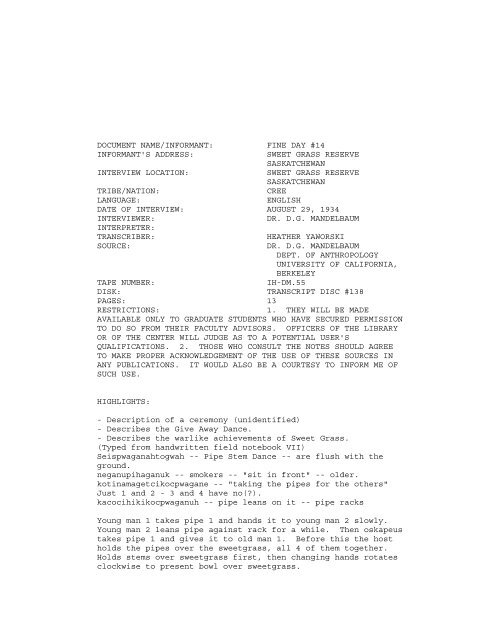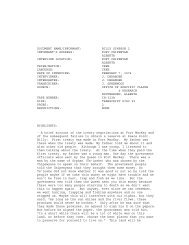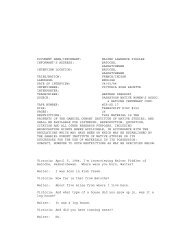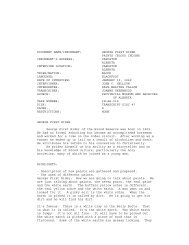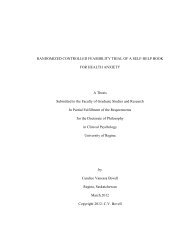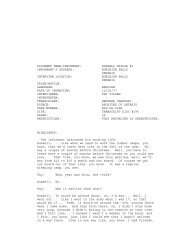document name/informant: fine day #14 informant's address - DSpace
document name/informant: fine day #14 informant's address - DSpace
document name/informant: fine day #14 informant's address - DSpace
You also want an ePaper? Increase the reach of your titles
YUMPU automatically turns print PDFs into web optimized ePapers that Google loves.
DOCUMENT NAME/INFORMANT: FINE DAY <strong>#14</strong><br />
INFORMANT'S ADDRESS: SWEET GRASS RESERVE<br />
SASKATCHEWAN<br />
INTERVIEW LOCATION: SWEET GRASS RESERVE<br />
SASKATCHEWAN<br />
TRIBE/NATION: CREE<br />
LANGUAGE: ENGLISH<br />
DATE OF INTERVIEW: AUGUST 29, 1934<br />
INTERVIEWER: DR. D.G. MANDELBAUM<br />
INTERPRETER:<br />
TRANSCRIBER: HEATHER YAWORSKI<br />
SOURCE: DR. D.G. MANDELBAUM<br />
DEPT. OF ANTHROPOLOGY<br />
UNIVERSITY OF CALIFORNIA,<br />
BERKELEY<br />
TAPE NUMBER: IH-DM.55<br />
DISK: TRANSCRIPT DISC #138<br />
PAGES: 13<br />
RESTRICTIONS: 1. THEY WILL BE MADE<br />
AVAILABLE ONLY TO GRADUATE STUDENTS WHO HAVE SECURED PERMISSION<br />
TO DO SO FROM THEIR FACULTY ADVISORS. OFFICERS OF THE LIBRARY<br />
OR OF THE CENTER WILL JUDGE AS TO A POTENTIAL USER'S<br />
QUALIFICATIONS. 2. THOSE WHO CONSULT THE NOTES SHOULD AGREE<br />
TO MAKE PROPER ACKNOWLEDGEMENT OF THE USE OF THESE SOURCES IN<br />
ANY PUBLICATIONS. IT WOULD ALSO BE A COURTESY TO INFORM ME OF<br />
SUCH USE.<br />
HIGHLIGHTS:<br />
- Description of a ceremony (unidentified)<br />
- Describes the Give Away Dance.<br />
- Describes the warlike achievements of Sweet Grass.<br />
(Typed from handwritten field notebook VII)<br />
Seispwaganahtogwah -- Pipe Stem Dance -- are flush with the<br />
ground.<br />
neganupihaganuk -- smokers -- "sit in front" -- older.<br />
kotinamagetcikocpwagane -- "taking the pipes for the others"<br />
Just 1 and 2 - 3 and 4 have no(?).<br />
kacocihikikocpwaganuh -- pipe leans on it -- pipe racks<br />
Young man 1 takes pipe 1 and hands it to young man 2 slowly.<br />
Young man 2 leans pipe against rack for a while. Then oskapeus<br />
takes pipe 1 and gives it to old man 1. Before this the host<br />
holds the pipes over the sweetgrass, all 4 of them together.<br />
Holds stems over sweetgrass first, then changing hands rotates<br />
clockwise to present bowl over sweetgrass.
Young man 1 takes pipe 2, hands it slowly to young man 2 who<br />
puts it in rack. When young man 1 takes pipe from rack he<br />
rotates it once clockwise. Young man 2 takes pipe and gives it<br />
to oskapeus who rotates it once and gives it to old man 1.<br />
When old man 1 gets pipe sits down near young man 1. Host does<br />
too. Old man 2 sits near young man 2. Young man 3 and 4 are<br />
told to sit close (?) by host.<br />
Then oskapeus gets up with stick 3 .... saskaispwuganagon<br />
"lights pipe with it", gets wood from fire, lights pipe.<br />
Then old man 1 holds up pipe. Old man 2 watches 1 and follows<br />
all his motions. Holds up pipe -- east, south, west, north.<br />
Then they puff it.<br />
When it is going well old man 1 passes it [Account of Smoking<br />
Tipi, cont. from (Handwritten Transcript Book V, p.101<br />
(#IH-DM.51, p. )]<br />
to old man 2. (I am not certain of this. He may simply hold<br />
it close to the gound in a horizontal position as he passes it.<br />
Fine Day gave both versions.) Old man 2 passes pipe 2 in the<br />
same way to young man 3. (Fine Day gave the vertical position<br />
of the pipe as the only one for pipe 2.) The pipes are smoked<br />
and passed on from young man 3 to young man 4 in the same way.<br />
Then the host gets them, knocks the ashes out and puts them<br />
back on the rack. Old man 1 and old man 2 go back to their<br />
original places as do young men 3 and 4.<br />
Old man 1 takes pipe 3 and gives it to old man 2. Old man 2<br />
holds it up and then puts it back on rack; the same is done<br />
with pipe 4. Then oskapeus gets up and gives pipe 3 to old man<br />
3 and pipe 4 to old man 4.<br />
The oskapeus makes new smudge at place marked "g" on diagram.<br />
Old man 1 takes the four rattles -- "e" and gives them to the<br />
oskapeus who shakes them four times as he holds them over the<br />
smudge. He goes up to old man 1 and feints at giving him the<br />
rattles three times -- he hands them over the fourth time and<br />
they are distributed one each to the four leaders.<br />
Oskapeus lights pipes 3 and 4 for old men 3 and 4 who puff and<br />
hold the pipes up. Then pipes 3 and 4 are passed around. As<br />
soon as the pipes go around old man 1 shakes his rattle and<br />
then starts to sing. The men who have the other three rattles<br />
help him as do the women. But the rest of the men in the tipi<br />
are silent. After old man 1 finishes his song he passes his<br />
rattle to old man 2 who in turn passes his rattle to old man 3,<br />
and so on. The holder of rattle 1 always sings his song and is<br />
helped by the other men who have rattles, and the women.<br />
When the pipes have gone around, the servers pass out the food.<br />
They start with old man 1 and proceed clockwise. If there is<br />
any food left the servers put it back near the fire. If a food<br />
bucket is emptied it is inserted into another empty bucket.<br />
After the food has been passed around, the younger men and<br />
women go home, taking with them the food they couldn't eat.
The host does not eat until the dance is over. He fasts for a<br />
<strong>day</strong> and a night before the dance.<br />
Some women stay, those who are going to sing with the singers<br />
all night. Those who have been sitting outside and want to<br />
stay can now come in for there is plenty of room.<br />
Then they begin to sing. They don't sing very many different<br />
songs. They sing around four times, i.e., each man gets to<br />
sing a song of his own four times. By then it is nearly<br />
<strong>day</strong>light.<br />
Then the host first takes the rattle and sings just one song<br />
but he sings a long time. The "Leaders" help him. When he<br />
gets through he lays his rattle down. The server gets it and<br />
the other three and smokes them over the sweetgrass. Then he<br />
throws the rattles through the air to old man 5 who sits near<br />
the door and has not sung heretofore. Old man 5 is called<br />
manitoayisi-yinu, "Manito Man", because he knows everything<br />
there is to know about the ceremony. The host has told him why<br />
he made the dance. He knows all the songs and all the<br />
pawaguauk. As he catches the rattles he tells the young men<br />
sitting around the tipi to come and sit near him. They do and<br />
he hands out the three extra rattles. Then he sings special<br />
songs for the occasion and the men around him and all the women<br />
join in. Then he sings for himself.<br />
After old man 5 has finished, old man 1 gets up and sits with<br />
young man 1 -- old man 2 with young man 2 -- old man 3 with<br />
young man 3 -- old man 4 with young man 4. The oskapeus passes<br />
one pipe to each old man. They all watch old man 1 and follow<br />
him as he smokes and holds up the pipe. Then they pass the<br />
pipes among themselves until old man 1 gets them all together.<br />
Then oskapeus breaks more sweetgrass on the smudge. Old man 1<br />
holds the pipes over it and talks to the pawagua. He says, "We<br />
have made the dance for you as it was promised." He talks for<br />
a long time and asks for many things. Then he puts the pipes<br />
back on the rack. The servers go outside the tipi and yell<br />
out, "Come and get the food that is left." The women come and<br />
get whatever there is. Then the oskapeus give some food and<br />
water to the host. That is the first time he eats. Then all<br />
go home.<br />
Sometimes two or three or four boys come into the tipi and<br />
stand between young men 3 and 4. They are naked and are daubed<br />
with white clay. They carry cloth offerings, we-piuacon and<br />
they cry. When the women hear them they cry too. One of the<br />
boys goes up to the host who asks him, "To whom are you going<br />
to give the cloth?" The boy answers, "It is something for so<br />
and so," naming some pauwagua. The host takes the cloth and<br />
gives the boy some pemmican to take home. The other boys do<br />
the same. Then the host holds up the cloths and talks. After<br />
the ceremony the host hangs the cloths in the bush.<br />
When old man 5 is singing the oskapeus shakes the pointed<br />
cloths as if to wake them.
Young men 1 and 2 sit in the same place until everything is<br />
over. They must be virgins. Sometimes they cry (because the<br />
fire burns?) and the women, hearing them, cry too.<br />
The excavation is about 4 or 5 feet across. The host furnished<br />
all the food. It takes a lot and his relatives help him. He<br />
must start saving pemmican in the winter for the next fall.<br />
Maxtaitcwiu -- Give Away Dance<br />
I can't tell you very much about it but I have joined in often.<br />
The one who gives the dance tells the others when it is going<br />
to be, some time in the fall or winter. He prepares a lot of<br />
food. The dance is given in a wewahtaho-ka-n. Inside this a<br />
post is erected that has a face carved on it. This is<br />
pakahkus, "Skeleton Ghost."(?) Beside it is a hide full of<br />
grease (see diagram).<br />
The food is passed around and all eat. Then the oskapeus takes<br />
the grease out of the hide and puts it on a pan. He gives it<br />
to old man 1 who takes the grease out of the pan. Then the<br />
drums and singing start and old man 1 dances towards old man 2<br />
holding the grease and making motions as though he were handing<br />
it to him. He sings, "This is what I am going to give you."<br />
Old man 2 dances toward old man 1 as though he were taking the<br />
grease. Old man 3 and old man 4 dance toward each other but do<br />
not have grease.<br />
After the first song old man 1 bites a piece out of the grease<br />
and spits it in the fire. Then he gives the fat to old man 2<br />
who dances toward old man 3 in the same way. So does old man 3<br />
to old man 4 and old man 4 to old man 1. Then the oskapeus<br />
cuts the fat up into little pieces and passes it around to<br />
everybody in the tipi. They each eat a little piece. Then the<br />
host gets up with an armful of clothes. He dances toward<br />
different men just as the old men danced with the fat and he<br />
passes out the clothes. He does not pass them all out in one<br />
song but a little at a time until all are gone that he has<br />
prepared.<br />
Then everybody dances and gives things away. You do not give a<br />
gift back to the original owner but you always give him<br />
something in return. If you give me brand new clothes I can<br />
give you old ones and it's all right. They dance that way for<br />
four nights, stopping during the <strong>day</strong>. Everybody who can dance<br />
does so. They don't have to go into the big tipi. When you<br />
come into a tipi with a gift, someone starts to sing and the<br />
two of you dance. They give everything away -- even horses.<br />
When guns are given away they shoot them off and yell.<br />
Everybody has lots of fun and when the dance is over you don't<br />
have anything that you had before.<br />
If someone cheats at the dance, i.e., if he gives only poor<br />
little things for food gifts he generally will have bad luck.
I got cheated like that once in a Give Away Dance. But I<br />
didn't mind even though I didn't have a horse with which to<br />
chase buffalo. The one who cheated me got a fast horse but he<br />
couldn't make use of it because he got blind soon after. The<br />
old people said, "He got blind because he cheated you."<br />
Pakahkus has strong power.<br />
Clothes were tied all over pakahkus. They are generally<br />
given to him by children who get the clothes from their<br />
parents. They dance in front of him as though he were a person<br />
getting a gift. After they dance, the children tie their gifts<br />
onto pakahkus but since they can't do it very well, their<br />
parents do it for them. A new pakahkus is made for every<br />
dance. After it is over the host puts the pakahkus in the<br />
bush. They sometimes bury clothes on the pakahkus after the<br />
dance.<br />
On the fourth night, just before the dance is over, four men<br />
dress up <strong>fine</strong>. They take bits of hair from every horse that<br />
has been given and tie them to sticks. Then everybody comes to<br />
watch while they dance before pakahkus with these sticks. When<br />
they are through they put the sticks on pakahkus.<br />
Not everybody can make this dance, only those who have dreamed<br />
it or vowed it or promised to give it for success in war.<br />
Men gave gifts to women and women to men as well as men to men<br />
and women to women. Walking over legs not good etiquette.<br />
Does not know why.<br />
Manisoniau wowikawikus -- "House where money is paid."<br />
This is a tipi that was put up at fairs and large gatherings.<br />
Women would prostitute there, young men would sleep there --<br />
not necessarily for intercourse but as a sort of lodging place.<br />
We did not have it before the whites came, we took a lesson<br />
from them. It is the word now used for whore house.<br />
Over the fire in most tipis there was a meat drying rack on<br />
four poles, called tecipitcigauis, "Hanger."<br />
Bow release -- arrow held between index and second fingers,<br />
right hand, three fingers on bow string -- thumb and little<br />
finger not used.<br />
We had no pounds of any kind except for buffalo.<br />
Kaputcikau is the fellow with the hump who hangs behind the<br />
others in the Cannibal Dance.<br />
Masiuape kiuikewiu -- "Shapes," Cat's Cradle. Men and women<br />
played it. They would try to beat each other.<br />
Both men and women go out to bring in meat after a kill. But<br />
in a big hunt the men keep on hunting while the women load the<br />
meat.
The meat is then the property of the women. The men don't do<br />
any more work on it.<br />
Pit baking -- a hole was dug inside the tipi. Indian turnips<br />
with the bark on are put into the hole and covered with hot<br />
ashes. In the morning they are well baked -- Mistaskucimiue.<br />
Roots were baked that way to make medicinal salt -- Mautomiuak.<br />
Meat was also prepared in that way. At the present their bread<br />
is baked that way.<br />
Nayah-tcigane-a-pi -- "Carrying Rope." This is a pack strap<br />
that came across the chest. Used only seldom, mostly on war<br />
trips.<br />
The Bush people use pack straps around each shoulder and from<br />
the head but the River people did not do this.<br />
Whips were made very decorative. The stock was a 24" piece of<br />
polished elk horn. Hole drilled in tip and another in side<br />
just below it. Whip of antelope saganapi passed through the<br />
two holes and fastened. Hole bored in butt and wrist loop<br />
covered with otter skin passed through.<br />
Pagama-guu -- War Club. Stick with stone encased in rawhide at<br />
top. Carried at night. Asiuipagama-guu -- Stone Club. Wrist<br />
loop. Mistigosagamaguu -- same but with two or three knife<br />
blades infixed instead of stone.<br />
At this point I asked Fine Day the same question I have asked<br />
before as to what it is that influences a man to vow to give<br />
one dance instead of another. I received no really<br />
satisfactory explanation.<br />
"I pick out a hard thing to do that I can't do without help. I<br />
have dreamt a little about the Sundance and so I have given<br />
that. I pick the hardest thing I can do and the most<br />
powerful."<br />
If a man vows to give a dance for a sick child, he must give it<br />
even if the child dies.<br />
Long ago there were no social dances. That came on with the<br />
white man.<br />
I am still at a loss to give an account for the influence that<br />
prompts the choosing of a particular ceremony instead of any<br />
other. Some of the factors may be:<br />
1. Previous familiarity with dance.<br />
2. Dream revelation.<br />
3. Difficulty of dance.<br />
4. General preference. I believe not to be the most<br />
important.
Northern Lights -- tcipay-uk, "Ghosts"<br />
The Indians believe that these are the spirits of the dead<br />
dancing in the sky. But the white men say that it is only the<br />
shadow of the ocean. I believe the white men too, for they<br />
have airplanes and they can go up at the sky and look at all<br />
these things. But I believe the old Indians too who said that<br />
it was the spirits of the dead dancing. For sometimes when<br />
there is a fresh fall of snow you can sometimes see a huge<br />
footprint -- a solitary one. Who could make it but the ghosts?<br />
I believe both explanations.<br />
Stars: eka-katohte-ta-tcahkos -- "Star that doesn't move"<br />
This is the North Star. When we got lost we could guide<br />
ourselves by it. All the other stars move except this one.<br />
Otce-gatahk - ? Handle of Dipper.<br />
Wapanatcahkos - Daylight Star - Shines brightly in the east<br />
just before morning.<br />
Oki-nauic - ? A group of seven little stars in the southwest.<br />
Okima-wukanictitcik - "Three Chiefs." Three bright stars close<br />
together in the southwest.<br />
Atcahkoskococit - Tailed Star. Evening star in the southeast<br />
which looks as if it had a tail.<br />
Those are all I know.<br />
The moon is another world with shining earth. The marks on it<br />
are those of different pawagua. So is it with the sun. The<br />
old Indians believed, although they didn't say it, that the<br />
stars were put there by manito to give light at night.<br />
Headgear<br />
Mihiyowes totiu -- "Cap with Hair On." Strip cut from back<br />
part of winter hide of buffalo. Ends sewn to make ring. Sinew<br />
basted near top and then drawn tight to form peak. Pieces<br />
added (sewn on) to cover neck and ears.<br />
Apiuac-tc-tiu -- Rawhide Hat<br />
Used in summer. Oblong piece of rawhide cut into this shape<br />
(see original for diagram). Hair scraped off but it is not<br />
greased. Then cross-cut in (see original for diagram) and the<br />
four triangles pushed up, and made so as to fit head.<br />
Triangles cut into strips -- whole allowed to dry and becomes<br />
very stiff. Notches cut all around brim and brim triangles and<br />
tips of crown strips colored red. Sometimes feathers stuck<br />
around brim.<br />
In describing this hat Fine Day laughingly said, "If I should<br />
see anybody wearing this hat now I should call him my<br />
grandfather."<br />
M-yowesaga -- Coat with Hair On
Coat made with peaked parkee attached. Open down front and<br />
fastened with saganapi -- knee length -- also belt of saganapi.<br />
No pockets, sleeves sewn in. The women measure the fellow<br />
that's going to wear it so that it will fit him.<br />
Fine Day never saw any rabbit skin clothing.<br />
Mica-hatato-paihiwiu -- "Many go fighting."<br />
This is what big war parties were called. They were undertaken<br />
so that the ukimau who was the leader would get a bigger <strong>name</strong>.<br />
The scouts go out to locate a camp and all approach at night.<br />
The ogihtcitau watch so that no one goes ahead. But sometimes<br />
the ogihtcitau will let their relatives go ahead and these men<br />
may get away with all the horses before the rest come up. They<br />
shoot and yell and attack, the enemy run. We chase and kill<br />
them and throw their tipi down. But soon the enemy gather in a<br />
group and they come back to fight. They can pick a good place<br />
but we are scattered. They kill many of us. When <strong>day</strong> comes we<br />
put the wounded on travois and go off. The ukimau doesn't<br />
fight. He sits back somewhere in a safe place and eats. The<br />
ogihtcitau come back and report how many they have killed.<br />
Then he tells them to stop. This is the leader -- if there are<br />
other ukimau along they fight right in front. He doesn't have<br />
to fight because he has fought many times before. If his men<br />
kill many of the enemy he gets to be a still greater ukimau.<br />
These large war parties were before my time. I saw them but I<br />
was too young to go along. Mihkwe-kiu, "Red Cloth," was one of<br />
the last leaders. He went against the Blackfeet. The next<br />
winter anutimi-wiyinu ka-stowe-skowa-t, "Stamps on Ashes," and<br />
ci-akask, "Growing," led expeditions. These were all chiefs but<br />
they were not as high as Sweet Grass.<br />
The leader would tell everybody that they were going and they<br />
could try to get as many men as possible. They might get 100<br />
men or even more. When they all get together they dance.<br />
The next <strong>day</strong> they dance again and the leader starts ahead with<br />
some other ukimauuk. They don't go very far and stop to make a<br />
fire and wait for the others. After they get warmed up they go<br />
on a little way and camp. That is the story I heard from the<br />
old people.<br />
Coup Counting<br />
Done in ogihtcitau tipi and in War Dance. Sometimes the<br />
different ogihtcitau tipis would get jealous of each other and<br />
have coup counting revelries. The ogihtcitau leader dances and<br />
tells his brave deeds. He tells them for the people there, not<br />
for manito.<br />
One man cannot count another's coup. But a son may recite his<br />
deceased father's deeds lest they be forgotten. Not long ago a<br />
nutimiwiyinu did that at a Sundance. He told the story and<br />
said, "My father did that, not I." His four brothers gave a
horse apiece to the poor for his telling the story. They<br />
picketed the horses right in the Sundance Lodge(?) and said,<br />
"Anybody that wants them may take them." But the men present<br />
were ashamed to take them. Later an old man gave the horses<br />
away to some old people.<br />
Long ago the Cree and the Assiniboine too would confess at the<br />
Sundance. I did this very thing three years ago. Those who<br />
are going to confess dress up <strong>fine</strong> and paint their faces as<br />
they used to for war. They come into the lodge and stand in a<br />
row. The oskapeus takes one by the wrist and leads him around<br />
to the singer. There the confessant faces the pole with his<br />
right arm raised and his finger pointing up. He sings a<br />
certain song. Then he says, "I went and killed an enemy. I<br />
scalped him. I took his horse. You gave me the power to do<br />
all this. Forgive me." Then he sings another song. I<br />
confessed three deeds -- the last one about the rebellion.<br />
They are called ntawatcimicuk -- confessants.<br />
The idea of asking forgiveness for so palpable a socially<br />
preferred virture puzzled me and I questioned Fine Day about<br />
it. First he said that when a man's children would be killed<br />
in war he would think, "Oh, I did wrong to go and kill the<br />
enemy. I'll confess." But even Fine Day agreed that it was<br />
not a satisfactory reason. He said that he himself could not<br />
explain why they should ask forgiveness. He said that he had<br />
been taught that it was a sin to go out and kill an enemy in<br />
his own country. But if he chased you after you stole some of<br />
his horses and wanted to kill you, it was no sin. The same<br />
applied to killing an enemy scout. But it turned out upon<br />
inquiry that both "sinful" and "sinless" deeds are "confessed"<br />
at the Sundance.<br />
Chief Sweet Grass had many deeds but I don't know just how they<br />
were told.<br />
When he was a child he heard his father telling of wars and<br />
fighting. When he was a young man he heard that there was<br />
going to be a war trip and many men were going. He told his<br />
father that he was going. His mother made moccasins for him<br />
and all the good new clothes that he would need. He was small<br />
in size and he had a good robe from a yearling buffalo.<br />
When the men gathered he saw them dance. The kihtco-ckinigiu<br />
sat in front and the scrubs sat behind. He thought that he<br />
would like to sit in front. Then they left. The kihtco-<br />
ckinigiu went ahead to scout. Sometimes they did not know how<br />
to scout and they would take anybody with them. When the<br />
scouts sight the enemy they sneak back and when they are near<br />
their fellows they yell to let them know.<br />
Sweet Grass went along with the kihtco-ckinigiu who were<br />
scouting. They told him to go back. "If you are close when we<br />
give the warning yell you will get deaf because you are only a<br />
scrub." But he went along. They sighted the enemy and came<br />
back to yell. Sweet Grass asked them what he should do. "Stay
far behind and you won't hear."<br />
He lagged behind close to the enemy camp. He saw two of them<br />
on horseback riding out to hunt. He hid and shot one as he<br />
rode by. He scalped him and chased the other who was running<br />
away. The horse Sweet Grass was on was faster than the other.<br />
He drew up. The ayah. got off to shoot. Sweet Grass got off,<br />
shot, killed him. Took his scalp and gun -- no clothes. He<br />
came back to the band and showed them the horses and scalps and<br />
guns. "Where did you get them?" He told and they all rushed<br />
to where the bodies lay to get scalps and the clothes. We used<br />
to get four or five scalps from one enemy.<br />
Then the ogihtcitau held the others back waiting for night.<br />
The two that had been killed had gone on a hunt and so they<br />
weren't missed. At night they advanced to the enemy camp.<br />
Sweet Grass rode one horse and lent the other one to another<br />
fellow. When they were close to the camp the ogihtcitau let<br />
some of their relatives go ahead to get horses. They got lots<br />
of them. Sweet Grass tied his horse and crept up to the camp.<br />
They yell. All of a sudden an enemy jumps out of a tipi in<br />
front of Sweet Grass and starts to run away. He must have been<br />
sleeping because he had one legging on one foot and one<br />
moccasin on the other. Sweet Grass chases him. The enemy<br />
stumbles -- falls. Sweet Grass clubs him with his gun, breaks<br />
the stock. The enemy is still kicking his one bare foot and<br />
the moccasined foot as Sweet Grass takes his scalp. Takes his<br />
gun.<br />
Sweet Grass came back and told what he had done. The<br />
ogihtcitau says, "You have done enough, don't go any further."<br />
"I will stop all night. In the <strong>day</strong> I will join in the fighting<br />
again." He went back and gave his scalps and guns away so that<br />
if he should get killed his father would know what he had done.<br />
At <strong>day</strong>light he put on his leggings and robe. "I am going down<br />
to fight." The enemy had made a trench and had laid timbers<br />
across. There was some wood near the pit but many Cree had<br />
been killed trying to sneak up. Sweet Grass advanced from tree<br />
to tree. They tell him not to do it for many had been killed<br />
that way. "Why do you yell when they shoot?" he said. He kept<br />
on and soon he got pretty close but he couldn't see anything.<br />
Bullets went all through his clothes but none struck him. He<br />
shot one of the enemy but he couldn't get to him. He came<br />
back.<br />
When the party returned the ones to whom he gave the scalps<br />
sang war songs. His father was glad to hear them and thought<br />
that he was an ukimau already. The next <strong>day</strong> they called him to<br />
stand in the Happy Dance.<br />
That same summer the River people and the West people were<br />
gathered to hunt buffalo. They sent two men out to look for<br />
buffalo and they saw five of the enemy on foot. They raised an<br />
alarm by riding their horses back and forth.
The enemy dug a pit with their knives on the side of a hill.<br />
Sweet Grass came up and was very glad to see what had happened.<br />
They shot. Sweet Grass crawled up. Another young fellow was<br />
just behind him. Finally the enemy were out of ammunition.<br />
Sweet Grass and the other fellow jumped in. They killed all<br />
five between them with their gun butts. Sweet Grass got one<br />
scalp, the other fellow got the rest.<br />
In that way he killed seven men in one summer. He then got<br />
married and soon after a chief picked him for ukimau because<br />
Sweet Grass had done more than he had.<br />
When a man took a scalp he was privileged to wear a feather in<br />
his hair. It was (?) into a little braid on the top of the<br />
head. This braid was never combed. Even if you took the scalp<br />
from a corpse that someone else had killed, you could wear the<br />
feather. Sometimes when all of the scalp was gone they might<br />
cut off a hand or a foot and call it a scalp. I myself was<br />
ashamed to take a scalp from a corpse after one scalp had<br />
already been taken.<br />
Sometimes a man would get up in a Sundance and tell how he had<br />
taken a scalp. We would know that he had taken the scalp after<br />
someone else had killed the man and they would say, "He ought<br />
to be ashamed to tell that he took a dead man's scalp."<br />
It counts as a very high deed to touch an enemy even if he gets<br />
away. It counted highest to grapple with an enemy. Other high<br />
deeds were to stick a spear into the enemy or to club him with<br />
a war club. It was higher to kill an enemy by clubbing him<br />
with a gun than by shooting him.<br />
Men who had been wounded painted marks on their clothes over<br />
the place where they had been hit. Arrow wounds did not count,<br />
only gun wounds. Men who had been wounded were sent around to<br />
collect ammunition and supplies for a group that was going to<br />
go on a raid.<br />
We only started the custom of shaking hands after the peace.<br />
Before that when a man would meet a friend they would kiss each<br />
other on the lips.<br />
If a Cree and an ayah. had boys that looked alike, one would<br />
take the other's son and kiss him, meaning that he took him for<br />
his own son.<br />
If an ukimau was almost as high as Sweet Grass, he would not<br />
walk between him and the fire.<br />
If a scrub comes into an ogihtcitau's tipi, he gets treated<br />
just as if he were an ogihtcitau himself.<br />
Buffalo hide robes were of two kinds -- atcimutahkwekop, War<br />
Story Robes, and pe-sahigauakoltp, Striped Robes. Both had the<br />
ears and the leg pieces which hung down slit and painted red.<br />
The tail was or<strong>name</strong>nted with quillwork. Both were merely
decorative. The war record painted on the (?) could be<br />
anyone's.<br />
The striped robe had two rows of parallel figures. They were<br />
either arrows or shaped thus (see original for diagram). The<br />
arrows were painted on with a kind of black dirt and then white<br />
clay was rubbed over the rest of the robe. The other design<br />
was painted on with a paint made of blood and a certain red<br />
flower. Then blood was rubbed over the hide.<br />
INDEX<br />
INDEX TERM IH NUMBER DOC NAME DISC # PAGE #<br />
CEREMONIALISM<br />
IH-DM.55 FINE DAY <strong>#14</strong> 138 2-4<br />
CEREMONIALISM<br />
-paraphernalia IH-DM.55 FINE DAY <strong>#14</strong> 138 4,5,6<br />
CLOTHING AND PERSONAL ADORNMENT<br />
-he<strong>address</strong>es IH-DM.55 FINE DAY <strong>#14</strong> 138 8,9<br />
CREE INDIANS<br />
-memories of old peopleIH-DM.55 FINE DAY <strong>#14</strong> 138 2-13<br />
DANCES AND DANCING<br />
-Give Away Dance (Cree)IH-DM.55 FINE DAY <strong>#14</strong> 138 4,5,6<br />
FOOD<br />
-preparation of IH-DM.55 FINE DAY <strong>#14</strong> 138 6,7<br />
NATURE<br />
-northern lights IH-DM.55 FINE DAY <strong>#14</strong> 138 8<br />
WARFARE, INTERTRIBAL<br />
-accounts of IH-DM.55 FINE DAY <strong>#14</strong> 138 11,12<br />
WARFARE, INTERTRIBAL<br />
-prestige in IH-DM.55 FINE DAY <strong>#14</strong> 138 9,10,13<br />
WEAPONS<br />
IM-DM.55 FINE DAY <strong>#14</strong> 138 7<br />
PROPER NAME INDEX<br />
PROPER NAME IH NUMBER DOC NAME DISC # PAGE #<br />
SWEET GRASS IH-DM.55 FINE DAY <strong>#14</strong> 138 10-13


